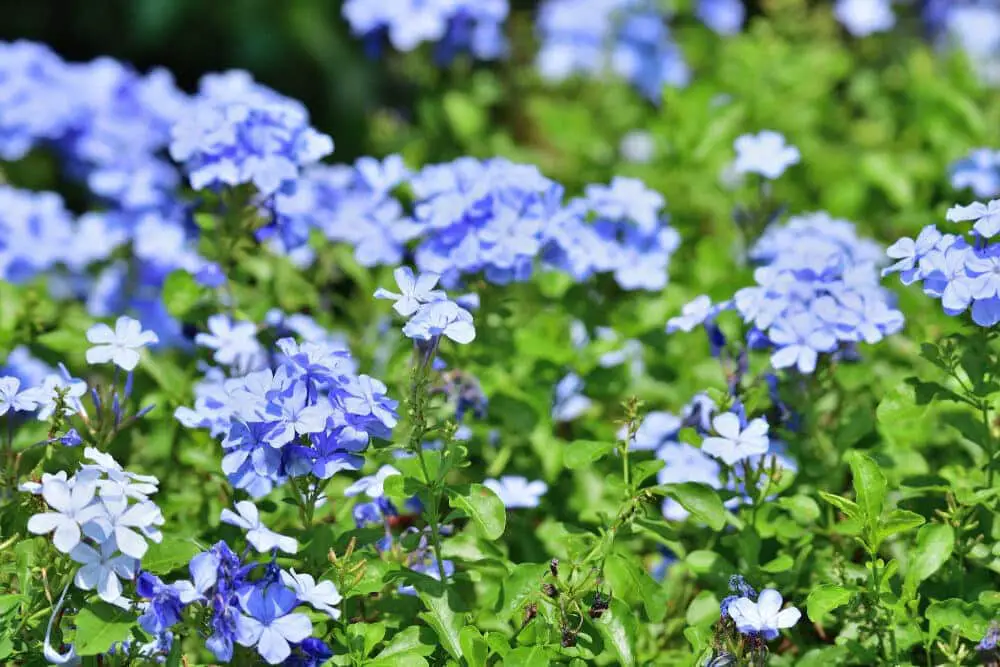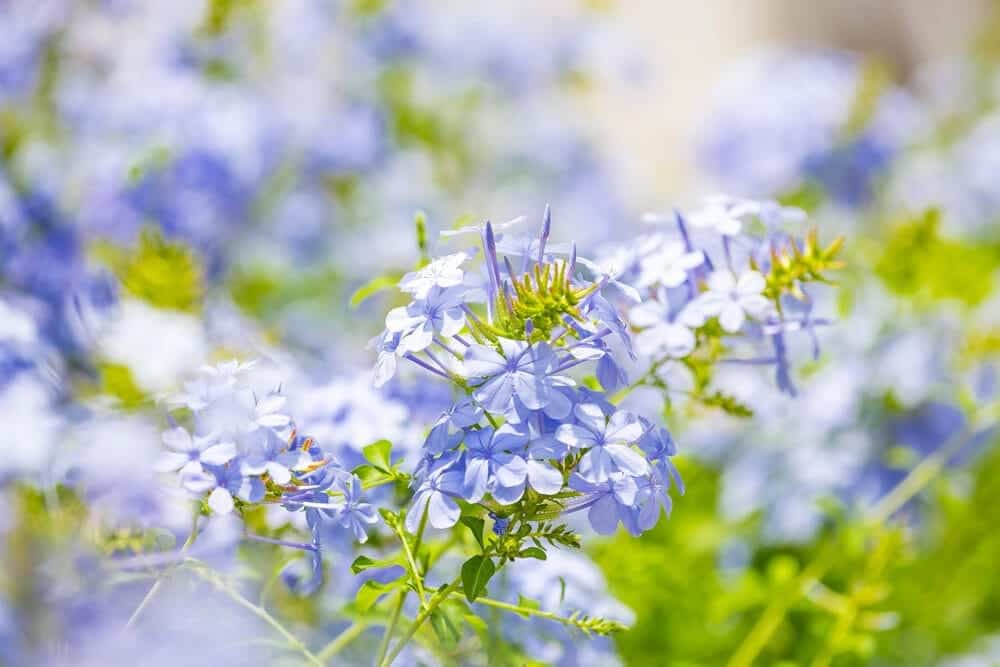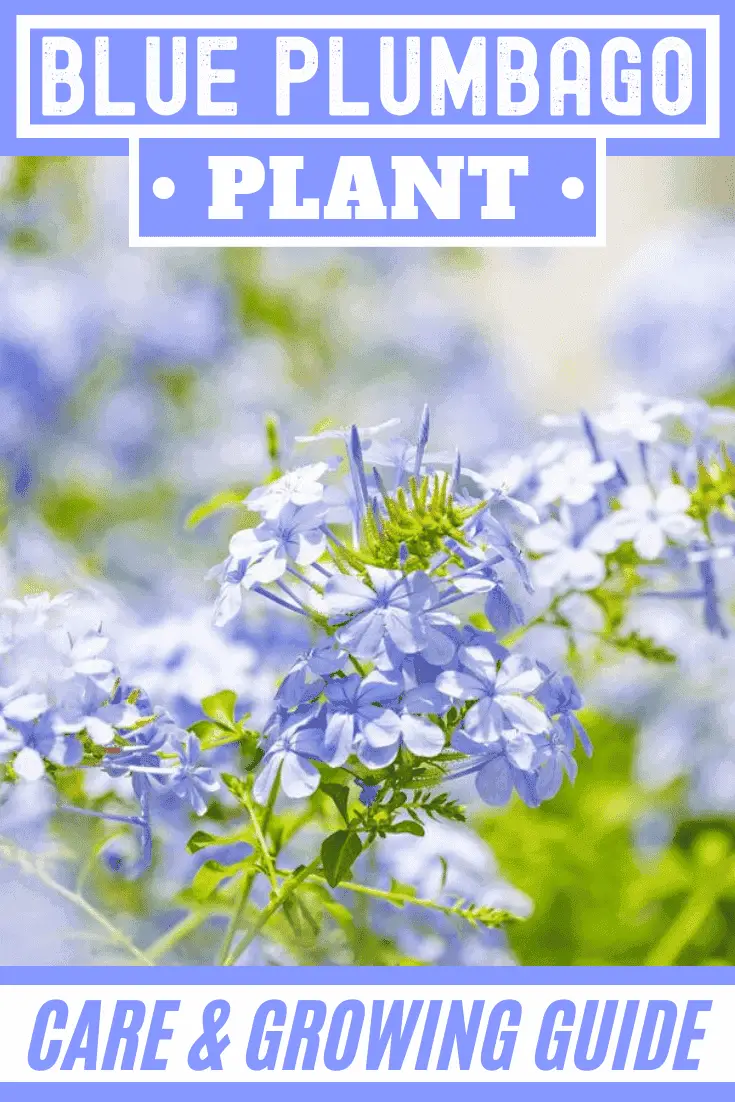The Blue Plumbago plant is a dream come true for gardeners who live in a sunny, mild environment.
This is a plant that is east to care for and is an attraction for wildlife and birds. You get to to enjoy the bright beautiful flowers and wildlife, including butterflies when you plant this flower.
It is a very versatile plant; use it as ground cover, trellis climber, container plant, and more.
Blue Plumbago Plant Care & Growing Guide
1. Light Requirement
It does best in direct sun so that it will really flourish. If it is grown in the shade, the flower production will not be at its best. When growing it in a planter, keep it on a windowsill with bright sunlight or anywhere there is full sunlight.
2. Water
The Blue Plumbago plant needs to be watered moderately. It is a plant that enjoys a good watering throughout spring and summer. How much water it will need depends on where you have planted it. It will need more water if it is grown in full sun but if it is kept in a shaded area, it won’t need as much.
If you grow your Blue Plumbago plant in a planter, you will need to be more careful with watering. The reason the potted one does not need as much water is because in the ground, the roots of the plants are branching out and getting moisture from other areas.
During the growing period, the Blue Plumbago plant will need a regular application of fertilizer that is high in potassium and phosphorus.
3. Soil
The soil should be slightly acidic with a light texture. It also needs to be well-draining. When planting a Blue Plumbago, indoors or outdoors, you should add some top soil or organic peat moss to the soil you are using. By doing this, you are enriching the soil.
4. Temperature
The ideal temperature for a Blue Plumbago plant would be 60-80 degrees Fahrenheit with moderate to high humidity. It does not like temperatures that are around 32 degrees Fahrenheit. Make sure that if you grow it indoors in a planter that you keep it away from heating vents or anything that dry the plant out and damage it.
5. Repotting
If you have it in a planter, you will need to repot it every two to three years. As a quick grower, it can rapidly fill your planter with roots. You may need to repot it sooner if you see it struggling for planter space. You should repot at the beginning of spring or early fall.
To see if it needs repotted, hold the base of the plant firmly and tug on it gently until the soil and root ball comes out of the pot. If you see condensed roots or you cannot get it out of the planter, then it is time to repot it. When repotting, rub the roots between your fingers to move as much old soil as you can. Then you are ready to replant it in a planter two sizes bigger than the one it came from.

6. Speed of Growth
It is a fast growing plant so it is important that you trim it to keep it looking nice.
7. Height and Spread
The Blue Plumbago plant can grow 6-10 feet tall and 6-10 feet wide and have clusters of flowers of one inch diameter.
8. Flowers
The flowers of the Blue Plumbago plant are an intense blue on slender stems with a pale green leaf and look similar to a phlox flower.
9. Trimming
If you live in a cooler climate, the Blue Plumbago will die off during the winter so it will need to be cut back to ground level so it will bloom next season and covered to protect it from frost.
Because the Blue Plumbago plant is a fast grower, you will need to trim it regularly to keep it in check. If you trim it during the growing period you will get more blooms because the flowers are on the ends of the new growth.

Is Blue Plumbago Plants Poisonous?
Although it is non-toxic to pets and other animals it is toxic to people. This includes all of the plant, from the sap to the foliage. Wear a long sleeve shirt and gloves to avoid skin irritation and maybe blistering.
Can Blue Plumbago Plants grow in Water?
No, you cannot grow this plant in water. The wood cuttings need to be grown in soil in order to get more plants.
How to get Blue Plumbago Plants to Flower?
You can get this plant to flower by adequate sunlight, right temperatures, and water and nutrients along with trimming them.
More like this: China Doll Plant Care & Growing Guide
Common Blue Plumbago Plant Diseases
Blue Plumbago plant is prone to a variety of diseases, including:
- Root rot—this is due to over watering and happens more in ones that are in a planter because the plant is holding on to the water because it only has drainage holes. Just keep the soil moist in planters.
- Yellow foliage—this occurs if the soil is on the alkaline side so to fix this, put some manganese sulfate around the plant.
Also read:
Conclusion
- In a warmer climate, this plant can bloom all year.
- It is relatively disease-resistant, pest-free, and deer-resistant.
- They are not frost-tolerant but are drought-tolerant.
- It can be an annual or perennial evergreen shrub.
- It is advised that you keep your Blue Plumbago plant trimmed to three feet or less to look its best.
- Before you do a hard trim, it is a must that you give the plant a good drink of water. The reason is that if you cut it dry, it will probably not entirely recover.
- You should fertilize at least three times a year; autumn, spring, and summer.
- A Blue Plumbago plant can be planted along a fence, line the deck or porch, around the trunks of trees but the trees need to let in enough sunlight for the plant to grow properly.

Victoria is the owner and main author of hobby plants. She loves spending her free time in her garden planting and taking care of her plants. Victoria hopes you enjoy the content here!
![Mother Of Thousands Plant [Complete Plant Care Guide] Mother Of Thousands Plant [Complete Plant Care Guide]](https://www.hobbyplants.com/wp-content/uploads/2022/07/mother-of-thousands-plant-300x158.jpg)
![Majesty Palm Plant Care: [Complete Beginner's Guide] Majesty Palm Plant Care: [Complete Beginner's Guide]](https://www.hobbyplants.com/wp-content/uploads/2022/08/majesty-palm-care-300x158.jpg)
![Exotic Angel Plant Care: [Complete Beginner's Guide] Exotic Angel Plant Care: [Complete Beginner's Guide]](https://www.hobbyplants.com/wp-content/uploads/2022/08/exotic-angel-plant-care-300x158.jpg)
![Snow White Waffle Plant: [Complete Care Guide] Snow White Waffle Plant: [Complete Care Guide]](https://www.hobbyplants.com/wp-content/uploads/2022/08/snow-white-waffle-plant-300x158.jpg)
![Waffle Plant Care: [Complete Beginner's Guide] Waffle Plant Care: [Complete Beginner's Guide]](https://www.hobbyplants.com/wp-content/uploads/2022/08/waffle-plant-300x158.jpg)
![Bird Of Paradise Plant Care: [Complete Beginner's Guide] Bird Of Paradise Plant Care: [Complete Beginner's Guide]](https://www.hobbyplants.com/wp-content/uploads/2022/08/bird-of-paradise-plant-300x158.jpg)
![Purple Passion Plant Care: [Complete Beginner's Guide] Purple Passion Plant Care: [Complete Beginner's Guide]](https://www.hobbyplants.com/wp-content/uploads/2022/08/purple-passion-plant-care-300x158.jpg)
![China Doll Plant Care: [Complete Beginner's Guide] China Doll Plant Care: [Complete Beginner's Guide]](https://www.hobbyplants.com/wp-content/uploads/2022/09/china-doll-plant-care-300x158.jpg)
![Polka Dot Plant Care: [Complete Beginner's Guide] Polka Dot Plant Care: [Complete Beginner's Guide]](https://www.hobbyplants.com/wp-content/uploads/2022/09/polka-dot-plant-300x158.jpg)
![Mona Lisa Lipstick Plant Care: [Complete Beginner's Guide] Mona Lisa Lipstick Plant Care: [Complete Beginner's Guide]](https://www.hobbyplants.com/wp-content/uploads/2022/09/lipstick-plant-mona-lisa-300x158.jpg)
![Yucca Cane Plant Care: [Complete Beginner's Guide] Yucca Cane Plant Care: [Complete Beginner's Guide]](https://www.hobbyplants.com/wp-content/uploads/2022/09/yucca-cane-plant-care-300x158.jpg)
![Bush On Fire Croton Plant Care: [Complete Beginner's Guide] Bush On Fire Croton Plant Care: [Complete Beginner's Guide]](https://www.hobbyplants.com/wp-content/uploads/2022/09/bush-on-fire-croton-300x158.jpg)